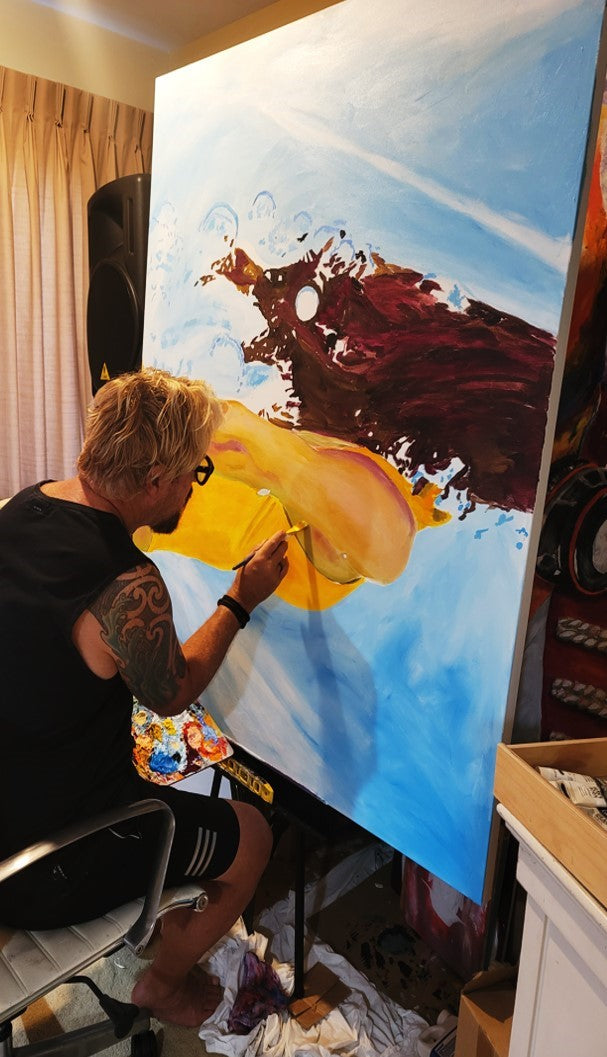ORIGINALS VS PRINTS
Original art vs reproduction art? When comparing original artwork to print reproductions, there are several key considerations and distinctions that art enthusiasts and collectors often consider. The choice between original and print artwork ultimately depends on individual preferences, budget, wall space considerations, artwork size, room design and other interior design aesthetics. Both original and print artwork have their own merits and appeal to different audiences for various reasons, and it is even sometimes difficult to tell the difference between the two.

Here are some important elements to consider when considering between original or reproduced art:
Original Artwork:
Uniqueness and Authenticity:
Original artwork is a one-of-a-kind creation, often made by the artist's own hand. Each piece carries the unique imprint of the artist's vision, technique, and expression, and each brushstroke carries a direct relationship to a moment in time for the artist when creating the work. The unique one-of-a-kind authenticity of an original artwork adds to its perceived value, as a direct production of the artist's creativity and skill.
Exclusivity and Prestige: Original art for some is a way to communicate their affluent lifestyle and distinguish themselves from others. Owning original art can signal social status, wealth, and success, and can be seen as a way to communicate their affluent lifestyle and distinguish themselves from others. Some art buyers or collectors are drawn to the prestige associated with the art, or the brand of the artist, along with the aspirational lifestyle they represent. Original art on their walls can be a form of self-expression and personal fulfillment, and they may derive pleasure from owning beautiful and luxurious artwork that reflects their tastes, preferences, and individuality.
Quality: Although in some cases it can be difficult to tell the difference between original and reproduction art, to the trained eye or to the perception of the viewer, there is a difference. The art quality can be seen and touched and is tacit, and art buyers often appreciate the creativity, vision and craftsmanship that go into creating great art, making them feel like they are experiencing something truly special.
Materiality and Texture:
Original artworks often have a tangible quality that can be appreciated through texture, brushstrokes, and the choice of materials. The physical presence of an original piece can evoke a tangible and tacit sense of connection with the artist's process and intention, as well as the historical context in which it was created. Consumers appreciate the creativity and craftsmanship that go into creating each product, making them feel like they are investing in something truly special.
Investment Value:
While original art often comes with higher price tags, many consumers view them as worthwhile investments. They believe that the art work will retain their value over time and may even appreciate in worth, making them a smart financial choice in addition to a luxury indulgence. Original artworks, especially those by renowned or sought-after artists or from significant periods in art history, can appreciate in value over time. Their one-off scarcity and cultural significance contribute to their investment appeal. The market for original artwork is driven by factors such as provenance, exhibition history, desirability, critical acclaim, and the artist's reputation.
Emotional Impact:
Owning an original artwork can evoke a deeper emotional response than a print reproduction, after all, it’s a real one-off original. The direct connection to the artist's hand and vision can imbue the piece with an exclusive élite personal or cultural significance.
Print Artwork:
Availability:
Print reproductions allow much greater availability of an artwork, that would otherwise be held by just one entity or person. There are thousands of examples of artworks that are popular as prints across the globe, many are iconic and instantly recognizable such as; The Birth of Venus by Sandro Botticelli, Starry Night by Vincent van Gogh, The Great Wave off Kanagawa by Katsushika Hokusai, The Kiss by Gustav Klimt, Water Lilies series by Claude Monet, Campbell's Soup Cans by Andy Warhol, and even Dogs Playing Poker by Cassius Marcellus – each proudly displayed in millions of homes and buildings across the world.

Affordability:
Print reproductions offer a more accessible way for art lovers to enjoy and own works by their favorite artists. They are often considerably more affordable than original artworks, making art collecting more inclusive and available to those who appreciate the art for what it means to them, or who just like the aesthetics, the brand of the artist, or the social statement the art is making.
Reproducibility and Consistency:
Prints allow artists to reproduce their work in multiple copies and can control the quality of the reproduction methods, maintaining consistency across editions. This enables a wider distribution of the artwork, enables the artist to maintain a high-quality of reproduction, and makes it more readily available to a much larger audience.
Size Versatility and Adaptability:
Print reproductions can be produced in various formats and sizes, allowing collectors to choose options that suit their preferences and living spaces. As an example a larger format piece of art that may be five feet by four feet as an original, can be reproduced at various smaller (or larger) sizes, more suited to specific wall dimensions and interior design themes. Because of the lower cost, printed art can also be used for educational purposes, exhibitions, office environments, and other commercial applications, contributing to the dissemination of art and cultural exchange.
Changing Times and Personal Tastes:
Because of their lower cost, reproduction art can be changed out if the buyers art preferences change without considerable cost. This also applies to reproduced artwork that does not stay relevant over time, or seems outdated such as 19th century Academic Salon Paintings, Velvet Elvis paintings, Victorian Genre Paintings, Surrealism and Fantasy Art, Neo-Expressionism, 1980s pop culture, and more that are no longer seen on contemporary walls today.
Preservation and Conservation:
Prints can be created using archival-quality materials and techniques, ensuring their longevity and preservation for future generations. Many of the reproduced pieces on today’s environmentally friendly papers and inks can last over 100 years, and unlike original artworks, prints are not subject to the same risks of deterioration or damage over time, making them a practical choice for institutional collections and long-term investment.
Value and Collectability:
While prints may not hold the same monetary value as original artworks, limited-edition prints or those signed by the artist can still have significant collectible value. The popularity of printmaking as an art form in its own right has led to a thriving market for prints, with dedicated collectors and specialized galleries.
In conclusion, the choice between original and print artwork ultimately depends on individual preferences, budget, personal preferences, and collecting goals. While original artworks offer a unique and irreplaceable direct connection to the artist's vision and techniques, print reproductions provide accessibility, affordability, and versatility. Both forms of art have their own intrinsic value and contribute fully to the rich tapestry of artistic expression and cultural heritage that you may well fully appreciate and hang on your wall.
“I want people to feel something when they experience my art.”
Peter Ashworth, is a California Impact Artist, who seeks to evoke profound emotions and inspire transformation through his art. As a creator, adventurer, and philanthropist, his purpose is to enrich lives and uplift communities worldwide.
'I have a hundred new creative ideas every day, many that manifest into my art.”
Believing in the power of exceptional art to engage, entertain, and uplift, he aims to spark imagination and encourage self-expression. With a keen eye for color and design honed over decades in corporate branding and advertising design, he crafts art that resonates with viewers, inviting them to think deeper and connect with their true selves. Through his creative process, Peter aims to make a positive impact on individuals, homes, society, and the environment. He sees a world where art creates impact and uplifting experiences, encourages well-being and fosters positive change in people.

Great Art Will Change Your Life.
Pair text with an image to focus on your chosen product, collection, or blog post. Add details on availability, style, or even provide a review."It is my genuine hope that my art in your home will bring about a profound transformation in your life. Beyond mere decoration, art has the power to evoke emotions, provoke thoughts, and inspire creativity, fostering a deeper connection with your surroundings. I believe art has the potential to uplift your mood, reduce your stress, and promote overall well-being,.... creating a harmonious and nurturing environment where you can thrive. By surrounding yourself with pieces of art that resonate with you, you can create a personal sanctuary that reflects your style, values, aspirations, and aesthetic preferences.
My art is designed from the first brushstroke .... to create
impact and stimulation in your environment. I have 6 different collections, each designed to provide you a unique, personalized, and interesting creative space. The presence of my art in your home or workplace will truly elevate your life, fostering a sense of meaning, creativity, and connection that can permeate into every aspect of your worldview and daily life."
Great Art Can Change The World
He also founded a non-profit (Humanity We -humanitywe.org) a highly innovative solution to address extreme poverty in small communities around the world. The purpose of Humanity We is to move entire poor communities out of dehumanizing generational poverty. His life purpose is to uplift the lives of others through art, philanthropy, and helping others live better lives.
20% of all proceeds from his art goes to fund Humanity We, a registered 501.c.3 charity, which maybe tax-deductible to you as an individual or organization.
The Origin Story
His creativity was inspired by his upbringing on farms in rural New Zealand, where he was transfixed with creative thinking, adventure, and the juxtaposition of colors, composition, and design. Throughout his life, he has traveled and lived in multiple countries of the world, living in the USA for the past 35 years. He is an avid sailing Captain who enjoys ocean sailing in the most interesting places around the world. For many years he has studied human thinking - how the brain perceives and assimilates information and experiences (neuroplasticity), and how humans experience emotional impact and create understandings and worldviews. He now lives in Southern California, one of the foremost creative epicenters of the world. He lives in a world-famous small artist town, Laguna Beach, living close to the Pacific Ocean, where he gets much of his daily creative ideas and inspiration. In his past careers, he spent many years managing super-luxury hotels around the world, then created six Marketing and Branding agencies, where he honed his CEO, Consulting, and Creative Design skills in business strategy, imaginative design, and human interaction – overseeing advertising and storytelling for many well-known global brands and hundreds of small & medium-sized businesses.
Live a smaller footprint.
My journey into sustainable artistry began with two simple yet profound questions to myself: (1) How can art be created without leaving a heavy footprint on the environment? ….and (2) How can art and creativity create more fulfilling lives for people, and influence them to live better with less? These questions ignited my quest for innovation and a deep dive into sustainable art practices that have come to define my artistic process and methodologies…. and my core worldview. I advocate for embracing a lifestyle that minimizes our environmental footprint, encouraging moderation in consumerism, resisting the urge for excessive consumption, and prioritizing low carbon-high sustainability lifestyles and values whenever possible.




